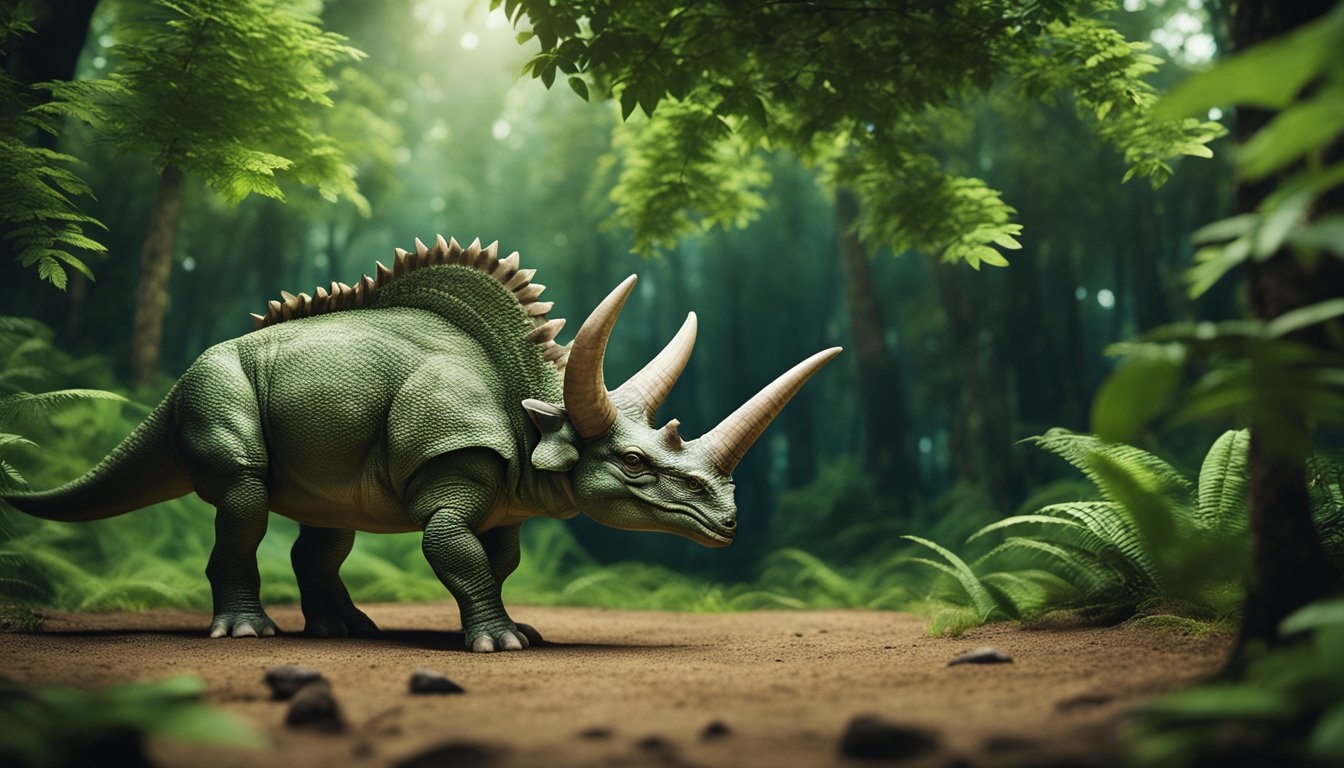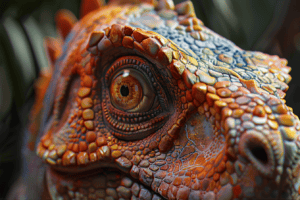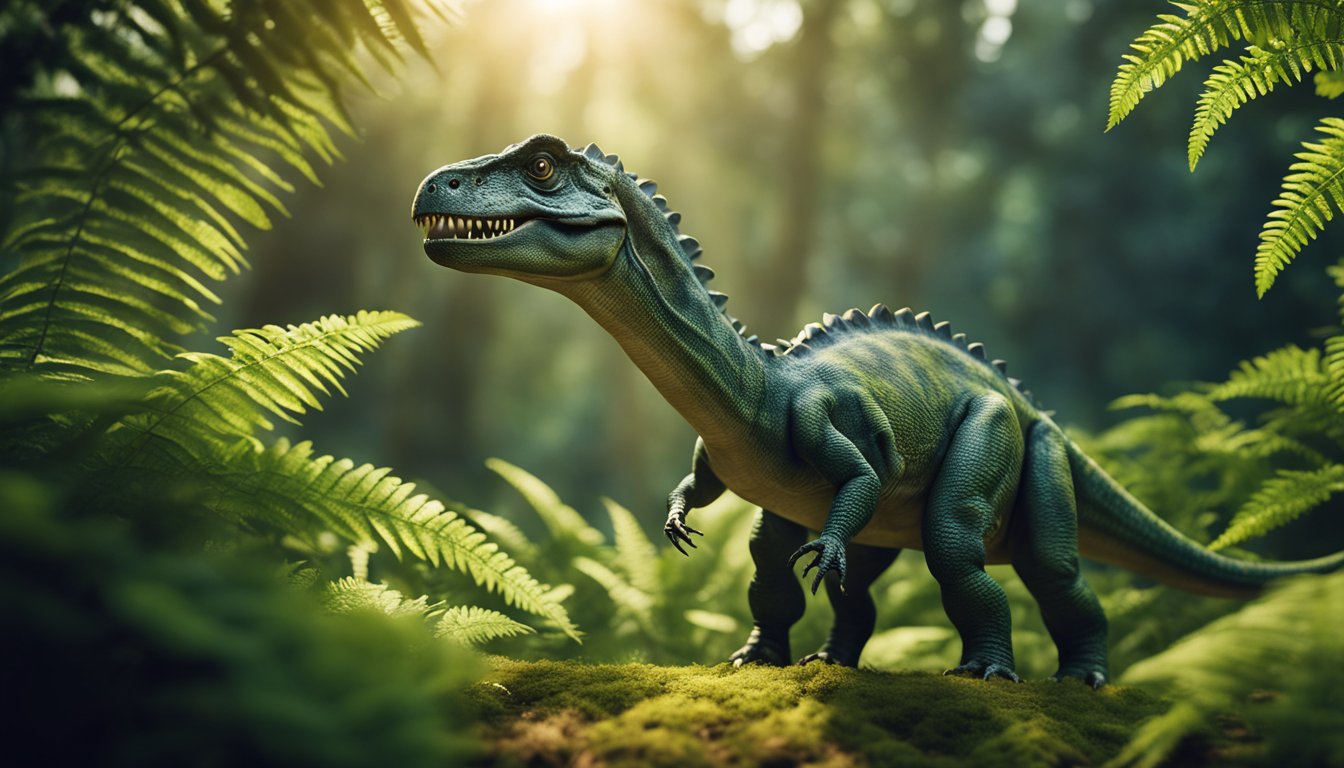Zuniceratops, the early relative of the famous Triceratops, is a fascinating dinosaur that roamed the earth millions of years ago.
Belonging to the Ceratopsia group, Zuniceratops was a herbivore with a distinctive frill and horns on its head.
Its name is derived from the Zuni people of New Mexico, where its fossils were first discovered.

Zuniceratops lived during the Late Cretaceous period, around 94-89 million years ago, in what is now the western United States.
Despite being a relatively small dinosaur, it played an important role in the evolution of the Ceratopsia group.
Its discovery shed light on the early evolution of horned dinosaurs and provided insight into the diversity of life during the Late Cretaceous period.
Dinosaurs have fascinated people for centuries, and Zuniceratops is no exception.
Its unique features and place in history make it a compelling subject for study and exploration.
By learning more about Zuniceratops and other dinosaurs, we can gain a better understanding of the natural world and the creatures that once roamed the earth.
Discovering Zuniceratops
Zuniceratops is a fascinating dinosaur that lived over 90 million years ago.
This dinosaur was a relative of the famous Triceratops, but had its unique characteristics that set it apart.
In this section, we will explore the discovery of Zuniceratops, including its first discovery and naming, as well as fossil finds in New Mexico.
First Discovery and Naming
Zuniceratops was first discovered in 1996 by Christopher James Wolfe, the son of paleontologist Douglas G. Wolfe.
Christopher was only eight years old when he found the fossils of this dinosaur while on a family trip to the Moreno Hill Formation in New Mexico.
The discovery was significant because it was the first ceratopsian dinosaur known to have brow horns and the oldest species recovered from North America.
The dinosaur was named Zuniceratops christopheri after its discoverer and the location where it was found.
The name Zuniceratops means “horned face from the Zuni Mountains,” as the fossils were found near the Zuni Mountains in New Mexico.
Fossil Finds in New Mexico
Zuniceratops fossils have been found in the Moreno Hill Formation in west-central New Mexico.
The Moreno Hill Formation is a geological formation that dates back to the Late Cretaceous period, approximately 93 to 89 million years ago.
The formation is known for its diverse fauna, including dinosaurs, mammals, and reptiles.
Paleontologists have found several specimens of Zuniceratops in the Moreno Hill Formation, including skull fragments, vertebrae, and limb bones.
These fossils have provided valuable insights into the anatomy and behavior of this dinosaur.
In conclusion, the discovery of Zuniceratops was a significant event in the field of paleontology.
The dinosaur’s unique characteristics and its relationship to the Triceratops make it an important species to study.
With continued research and exploration, we may learn even more about this fascinating dinosaur and its place in the natural world.
Anatomy of Zuniceratops

Zuniceratops is a fascinating dinosaur that roamed the earth during the Late Cretaceous period, about 94 to 89 million years ago.
This herbivorous dinosaur is a ceratopsian, which means it had a distinctive frill and horns on its skull.
In this section, we will explore the anatomy of Zuniceratops, including its horns, skull, teeth, and body size and structure.
Distinctive Horns and Frill
One of the most striking features of Zuniceratops is its horns and frill.
Unlike other ceratopsians, Zuniceratops had brow horns and a frill that was fenestrated, meaning it had holes in it.
The brow horns were short and pointed forward, while the frill was triangular and had a wavy edge.
The frill was probably used for display, and it may have helped regulate body temperature or protect the neck from predators.
Skull and Teeth
Zuniceratops had a large skull that was about 3 feet long. The skull had a prominent beak-like structure that was used to grasp and tear vegetation.
The teeth of Zuniceratops were arranged in a battery, which means they were tightly packed together in a row.
The teeth were leaf-shaped and had serrated edges that were used to slice through tough plant material.
Body Size and Structure
Zuniceratops was a relatively small ceratopsian, measuring about 10 feet long and weighing around 500 pounds.
It had a bulky body with a broad hip and a long, robust tail.
The hip bones of Zuniceratops were fused together, which made its pelvis more rigid and provided more support for its hind legs.
The ischium bone, which is part of the hip, was elongated and helped anchor the muscles that controlled the tail.
Zuniceratops had large eyes that were positioned on the sides of its head, which gave it a wide field of vision.
In conclusion, Zuniceratops is a fascinating dinosaur with unique features that set it apart from other ceratopsians.
Its distinctive horns and frill, large skull and teeth, and bulky body size and structure make it a fascinating subject for paleontologists and dinosaur enthusiasts alike.
Zuniceratops in the Ecosystem

Diet and Herbivory
Zuniceratops was a herbivorous dinosaur that lived during the Late Cretaceous period in North America.
It is believed to have been a browser, meaning that it fed on leaves, twigs, and other vegetation found in its habitat.
Its teeth were adapted for grinding plant material, and its beak-like mouth was perfect for snipping off branches.
One interesting fact about Zuniceratops is that it had a unique arrangement of teeth compared to other ceratopsians.
Its teeth were arranged in a way that allowed it to slice through tough vegetation like a pair of scissors.
Habitat and Coexistence
Zuniceratops lived in what is now known as western New Mexico, alongside other dinosaurs like the tyrannosaurid dinosaur, Bistahieversor, and the hadrosaurid dinosaur, Kritosaurus.
It is believed that Zuniceratops lived in a forested environment, where it could find plenty of vegetation to feed on.
Zuniceratops was not the only horned dinosaur in its ecosystem. In fact, it lived alongside other ceratopsians like Pentaceratops and Chasmosaurus.
These dinosaurs likely competed for resources like food and water, but they also coexisted peacefully.
Overall, Zuniceratops was an important member of its ecosystem. As a herbivore, it played a crucial role in maintaining the balance of the food chain.
Its unique adaptations allowed it to thrive in its environment, and its presence helped to shape the ecosystem in which it lived.
Evolutionary Significance

Zuniceratops is a remarkable dinosaur that has provided us with valuable insights into the evolution of ceratopsian dinosaurs.
This early relative of the famous Triceratops lived during the Late Cretaceous period, about 94-89 million years ago.
It is notable for possessing unique features that set it apart from other ceratopsian dinosaurs.
Link to Later Ceratopsians
Zuniceratops is important because it is the oldest known North American ceratopsian dinosaur.
Its discovery has helped to support the theory that the horned ceratopsians evolved in North America, rather than in Asia as previously thought.
Zuniceratops is also significant because it provides a link between the early protoceratopsids and the later ceratopsids, such as Triceratops.
Unique Features and Diversity
Zuniceratops is unique among ceratopsian dinosaurs because of its mosaic of features.
It had brow horns, which were elongated and pointed forward, and a frill that was fenestrated, meaning it was not solid bone.
These features are primitive and set it apart from later ceratopsids, which had shorter brow horns and a solid frill.
Zuniceratops was also small in size compared to other ceratopsian dinosaurs, measuring only about 3 meters in length.
The diversity of ceratopsian dinosaurs is evident in the range of physical characteristics and skeletal features that they possess.
Zuniceratops is an important part of this diversity, and its morphology has helped to shed light on the evolution of ceratopsian dinosaurs.
Its unique features and primitive nature make it an interesting dinosaur to study, and its discovery has contributed greatly to our understanding of the family tree of ceratopsian dinosaurs.
In conclusion, Zuniceratops is an important dinosaur in the study of ceratopsian dinosaurs.
Its discovery has provided valuable insights into the evolution of these fascinating creatures, and its unique features and diversity make it an interesting subject of study.
The Arizona Museum of Natural History has a reconstruction of Zuniceratops on display, allowing visitors to get a glimpse of this remarkable dinosaur.
Frequently Asked Questions

How did Zuniceratops differ from its famous cousin, the Triceratops?
Zuniceratops was a smaller and more primitive version of the famous Triceratops.
One of the main differences between the two dinosaurs is the number of horns on their heads.
While Triceratops had three horns, Zuniceratops only had one, located on its nose.
Additionally, Zuniceratops had a shorter frill at the back of its head, which was less ornate than that of Triceratops.
Can you list some unique characteristics of Zuniceratops?
Zuniceratops had a unique combination of features that set it apart from other ceratopsians.
In addition to its single nasal horn and short frill, Zuniceratops had a pair of small horns above its eyes, which curved forward.
It also had a broad, flat beak that it used to slice through vegetation.
Which dinosaurs are considered close relatives of the Triceratops?
Triceratops belonged to a group of horned dinosaurs called the Ceratopsidae.
Other members of this group include Styracosaurus, Chasmosaurus, and Pentaceratops.
These dinosaurs are known for their elaborate frills and horns, which they used for display and possibly for defense.
What era did the Zuniceratops live in, and what was its habitat like?
Zuniceratops lived during the Late Cretaceous period, around 90 million years ago.
It lived in what is now western North America, in a habitat that was likely forested and humid.
The area was also home to other dinosaurs, such as the duck-billed hadrosaurs and the carnivorous tyrannosaurs.
How do paleontologists believe the Zuniceratops used its horns?
Paleontologists believe that Zuniceratops used its single nasal horn for display rather than defense.
It is thought that the horn was brightly colored and used to attract mates or intimidate rivals.
The small horns above its eyes may have served a similar purpose.
What evidence do we have of the Zuniceratops’ existence?
The first fossils of Zuniceratops were discovered in New Mexico in 1996. Since then, several more specimens have been found in the same area.
These fossils include parts of the skull, jaws, and teeth, as well as some limb bones.
From these remains, paleontologists have been able to reconstruct what Zuniceratops may have looked like and how it lived.







